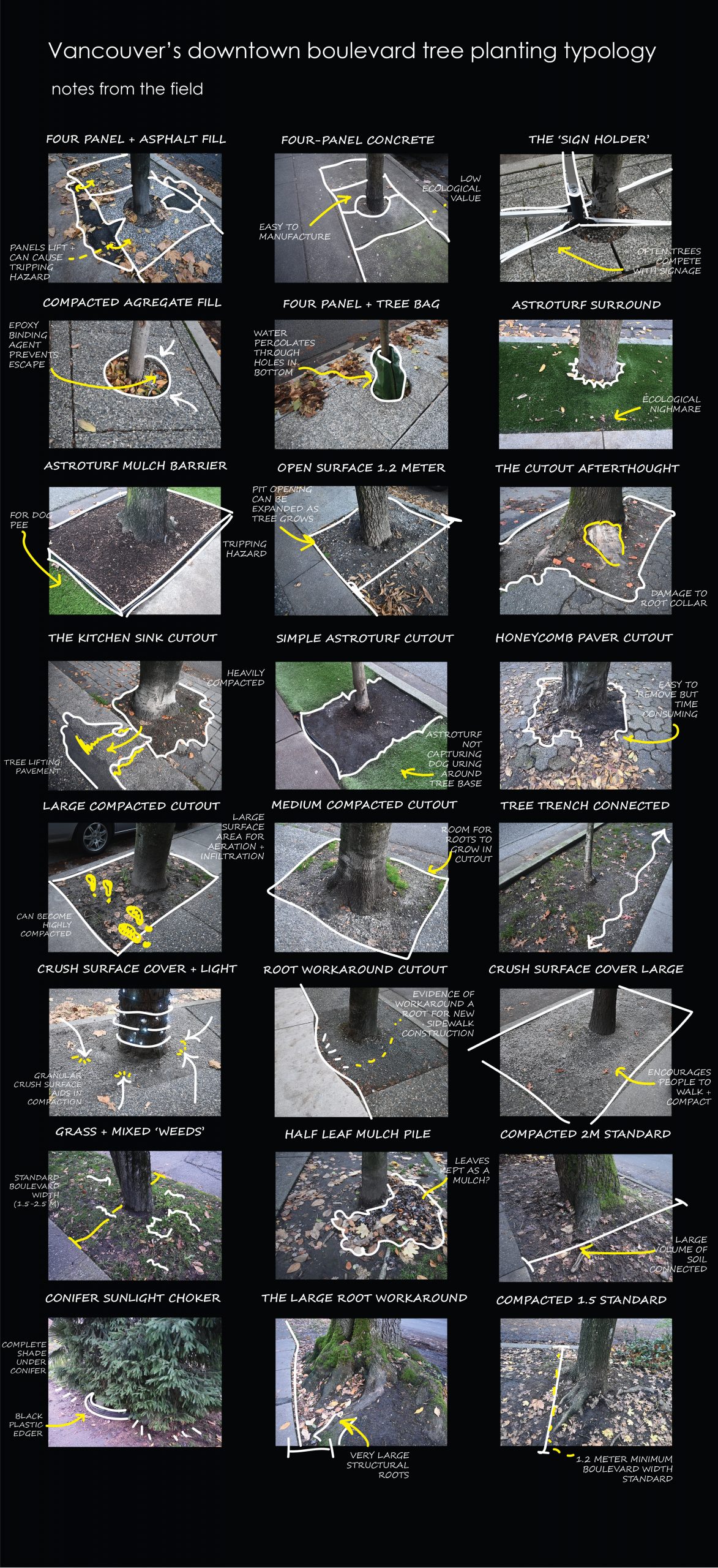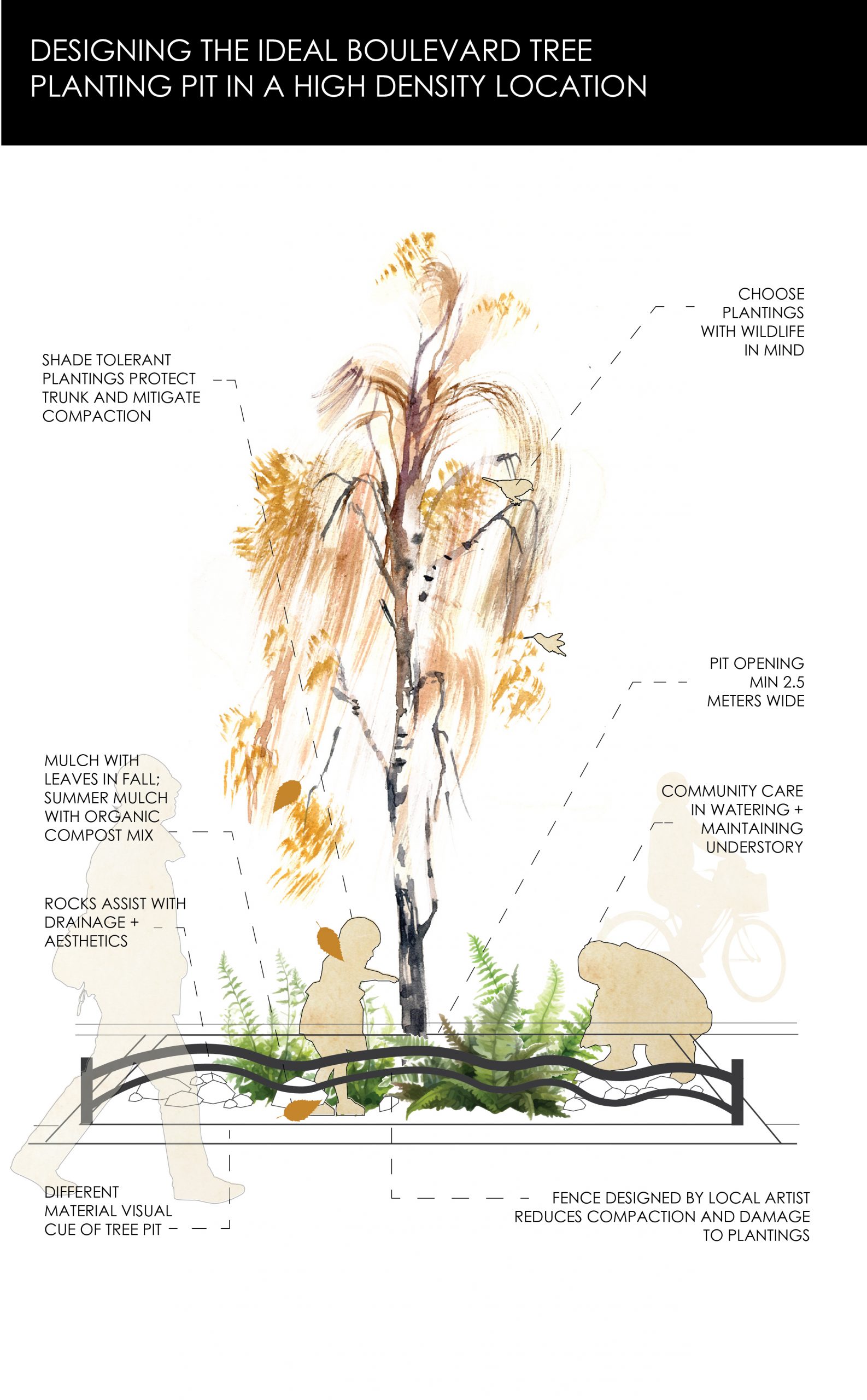“Architects, civil engineers, and many landscape architects see paving as the primary element in the design. They either do not know how their decisions affect tree health or may shrug these concerns off in the belief that trees can be replaced when they die”
– James Urban, FASLA; specialist of trees and soil in urban landscapes
Trees provide countless benefits to human and non-human beings in the landscape, from cooling impervious surfaces during hot summer days to reducing surface runoff from entering storm drain systems. In a changing climate, Vancouver is experiencing hotter, drier summers and heavier storm events, increasing the importance of planting and managing trees that are adaptive to climate change. As trees can live well beyond a human lifetime if provided healthy conditions, landscape architects need to know the best practices for planting and protecting trees in the landscape. This section was adapted from the work of James Urban, a specialist of trees and soil in urban landscapes, and best practices from the report Recommendations to improve the health of Vancouver’s street trees surrounded by hardscape (2023).
You can listen to a podcast interview between UBC SALA students and James Urban on the role of landscape architects in tree design here: Foliage Footprints (2024), by Garrett McGill, David McKenna, and Ang Zhai.
Cercidiphyllum japonicum (katsura) trees provided with appropriate soil volume in a residential neighbourhood in Vancouver. Note the wide boulevard width (~3 meters) and healthy canopy. (Photo credit: Elliot Bellis, 2023).
Local legislation, reports, and standards
Local planning and policies are important for landscape architects to be aware of when working on new development applications, as protections apply to trees in the City of Vancouver. The following are local policies, plans, and bylaws associated with trees in Vancouver:
- City of Vancouver Urban Forest Strategy (2018) – Guides the Park Board’s management and protection practices for trees in the urban forest, including setting a canopy cover target of 30% by 2050. Municipalities set canopy cover targets to track planting overtime with a general target of 30% canopy cover as best practice. Seattle has set a 30% canopy cover by 2037, Portland 33% by 2035, and Toronto 40% by 2050 (City of Vancouver).
- Vancouver Protection of Trees Bylaw 9958 – Regulates trees on private property and specifies trees with a diameter (width) of 20 centimetres or greater, measured at 1.4 metres above ground require a city permit. Trees identified as replacement trees or part of a landscape design for a new development project also require a tree removal permit, including if smaller than 20 centimetres.
- Vancouver Street Tree Bylaw 5985 – Regulates the Vancouver Park Board’s management of trees on boulevards and medians on City-owned streets.
- Recommendations to improve the health of Vancouver’s street trees surrounded by hardscape (2023) – A report written through the UBC Sustainability Scholar’s program providing recommendations to the City of Vancouver’s Engineering department to improve standards for tree conditions, including an increase from 1.2 to 1.5 meter minimum boulevard widths.
- Standard Detail Drawings (2019) – Vancouver has general detail drawings specific to street trees including G10.2 – Tree four-piece tree surround, G11.3 – Planting median planting
- City of Vancouver Construction Specifications (2019) – Includes standard practices for planting and construction including stock acquisition, planting methods, watering, mulching, and establishment of tree planting sites.
- City of Vancouver Engineering Design Manual (2019) – For both capital projects and contracted private development where public trees are involved, Vancouver’s Engineered Design manual outlines standards for design practices including utility setbacks and clearances, species selection, tree placement, soil volume, street horticulture, and growing medium.
Soil volume for trees
One of the most important insurances to grow a tree to full maturity is providing enough soil volume for roots to access available water and nutrients. In urban landscapes, trees struggling in limited soil volumes can experience further decline from one or more compounding factors including inappropriate species selection, over or under-watering, disease, and vehicular damage (Minnesota Pollution Control Agency, 2023). Best practice recommends 1-3 cubic feet per square foot of tree canopy cover, dependent on irrigated conditions and a tree species’ capacity to tolerate drought (Urban). Most importantly, the soil volume minimum should be of a quality growing medium, as structural (engineered) soil won’t provide available nutrients to ensure proper rooting volume.
For the Metro Vancouver region (Metro Vancouver, 2017), best practice for soil volume minimum and tree spacing is:
| Tree size | Soil volume | Spacing |
| Large | 45-150 m3 | 12-15 m |
| Medium | 20-70 m3 | 10-14 m |
| Small | 15-30 m3 | 6-9 m |
Tree species selection
Diversity of tree selection in a planting plan is critical to minimize the risk of impact from new or introduced pests and diseases. A general rule of thumb is the 10-20-30 rule to plant no more than 10% of any species, 20% of any genus and 30% of any family (Santamour, 1990).
The designer should also ensure trees planted are climate-adaptive, looking for trees that are drought tolerant but can withstand increased rainfall from heavy storm events in the Pacific Northwest. A list of climate-adaptive trees for the Metro Vancouver region can be found here: Urban tree list for Metro Vancouver in a changing climate. A few trees recommended to be very suitable to our climate in the future include:
- Calocedrus decurrens – incense cedar
- Celtis occidentalis – common hackberry
- Crataegus x lavalleei – Lavallée’s hawthorn
- Fraxinus ornus – flowering ash
- Koelreuteria paniculata – golden rain tree
- Maackia amurensis – amur maackia
- Phellodendron amurense – amur cork tree
- Pinus contorta – lodgepole pine
- Pinus nigra – black pine
- Quercus acutissima – sawtooth oak
- Quercus coccinea – scarlet oak
- Ulmus propinqua – Emerald Sunshine elm
Tree root terminology
Tree roots are often conflicted by impervious hardscapes, utilities, and compaction activities including pedestrian and vehicular damage. In general, trees will add stronger roots in the direction of an opposing force (e.g. tree leaning on one side, roots will develop in the opposite direction of lean). The designer needs to learn key terminology surrounding trees. The following are adapted definitions from James Urban:
- Lateral roots – the largest tree roots connecting the absorbing root system to the trunk provide structural support for a tree’s endurance to wind and gravity. Lateral roots develop as the root grows a corky protective barrier and they can grow up to ten feet per year depending on species and condition which is much faster than branches.
- Root grafting – when roots from neighbouring trees of the same or different species come into contact, they can graft and become one which can result in vascular diseases and fungal infestations spread between.
- Tap root – a single root growing straight into the soil until limited by oxygen, storing carbohydrates and proteins (Undersander, 2019). In most conditions, the horizontal (lateral) tree roots overtake a tap root. At the nursery, the taproot may be cut in production. The size of a tap root is species dependent and the majority of trees lack a tap root in maturity (Pankau, 2024).
- Buttress roots – roots that spread the loading over tree in larger area. Typically they are 2-4 inches in diameter about six feet from the trunk. No buttress roots should ever be cut or damaged.
- Girdling roots – Root may grow at or near the surface over the top of root collar and suppress structural development. If a tree has no trunk flare, it could be the result of girdling roots. In young or nursery-grown trees, girdling roots should almost always be removed.
- Root crown/collar – the transition zone between a trunk and roots. From the designer’s perspective, this should be the second most important part of the tree after the roots. The rapid growth at the base must be factored into any design of paving around a tree and nothing must be allowed to interrupt growth.

A removed semi-mature street tree whose trunk flare was not provided with appropriate space in the boulevard right-of-way. Roots can be seen pushing up paving to the right and asphalt was poured over the trunk flare to mitigate tripping hazard. (Photo credit: Elliot Bellis, 2023)
Design considerations for trees in hardscapes
The following are best practices for designing trees into hardscapes, particularly for urban streetscape conditions adapted from James Urban and best practices from ISA-certified arborist, Elliot Bellis.
Typical urban streetscape with tree planting typologies in Vancouver, British Columbia including materials and associated pros and cons; graphic credit: Elliot Bellis.
- Minimize soil compaction – The ground around the base of a tree will be subject to compaction and in pedestrian-heavy areas, strategies should be in place to minimize the effect of compaction which can reduce pore space, decreasing soil health and the ability for the tree to receive oxygen and water. Incorporating fencing, elevated curbs, or strategizing a drought and shade-tolerant understory planting can be helpful compaction mitigation strategies.
- Rethink tree grates – Avoid installing paving or grates immediately around the base of the tree. As roots grow, paving and grates will need removal or repair, requiring intensive maintenance and often lack of maintenance can damage a tree’s roots and trunk. Instead, an organic surface cover of mulch or non-competitive and low-maintenance ground cover is best.
- Maintain air space for roots – Roots push hardscape sidewalks to access the water that condenses in the space between the granular crush layer and the concrete sidewalk, lending costly repairs and accessibility hazards. Instead, the best practice is to design suspended paving to maintain the air space between the underside of paving and soil. Subbase material should be limited in size range with no fine particles to minimize penetration under the pavement. 5-6 inches of gravel is recommended under 6 inches of reinforced concrete on a standard 4-inch walk to reduce paving conflicts.
- Prioritize long narrow tree openings to provide the greatest amount of open soil while maintaining walkable space. Tree boulevards should be a minimum of 1.5 meters in width when specifying boulevard design.
- Utilize root barriers to deflect roots into deeper soil and place them adjacent to paving. Root barriers should be vertically ribbed and placed at the top edge of barrier above soil and mulch.
- Use mortar set pavers along the edge of loose set pavers to reduce root intrusion into the sand-setting bed. The use of a concrete edge around the tree opening will secure the pavers and allow for a larger soil volume.
- Incorporate soil cells where soil volume currently can’t be met to expand soil volume under hardscapes. Soil cells utilize lightly compacted soil to fill void space and expand the ability to plant trees in limited spaces. See the Silva Cell product for more information.
- Install engineered or ‘structural’ soil. Structural soil is often utilized under sidewalks and/or utilities to create additional growing medium for tree roots while providing structural support for the sidewalk using a mix of compacted gravel and soils. Careful consideration should be taken when assessing soil volume as the rock component reduced the total soil volume.
Detail drawing of a soil cell (Silva Cell) system. More open access standard drawings can be found here. (Deeproot)
Case study: tree pits in Vancouver
The following are exploratory field observations of tree planting typologies recorded from Vancouver, British Columbia’s downtown boulevard trees in September 2023 by Elliot Bellis. Generally, trees in residential areas with larger boulevard minimums, open soils, and understory plantings cared for by the community were observed living to more mature ages and healthier tree conditions. Based on these observations, an ideal tree planting typology for trees in hardscapes was visualized below.





